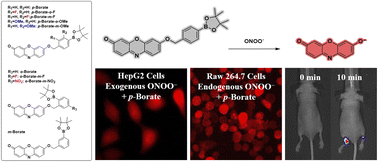Regulating the activity of boronate moiety to construct fluorescent probes for the detection of ONOO−in vitro and in vivo†
Abstract
Abnormal intracellular peroxynitrite (ONOO−) concentration is related to oxidative damage, which is correlated with many pathological consequences, such as local inflammation and other diseases. In this work, a series of resorufin benzyl ether-based fluorescent probes were designed using boronate as a recognizing moiety installed on a phenyl moiety for ONOO− detection via a self-immolation mechanism. The location of the boronate as well as the substitution patterns on the phenyl moiety were investigated and the responding behaviors of the designed probes to ONOO−, other reactive oxygen species, and biothiols were examined. It was found that all the immolative probes were inevitably dominated by ONOO−. Compared with other probes, p-Borate possessed favorable selectivity and high sensitivity to ONOO−. Moreover, p-Borate was successfully used to detect ONOO− in cells and inflamed mice.



 Please wait while we load your content...
Please wait while we load your content...